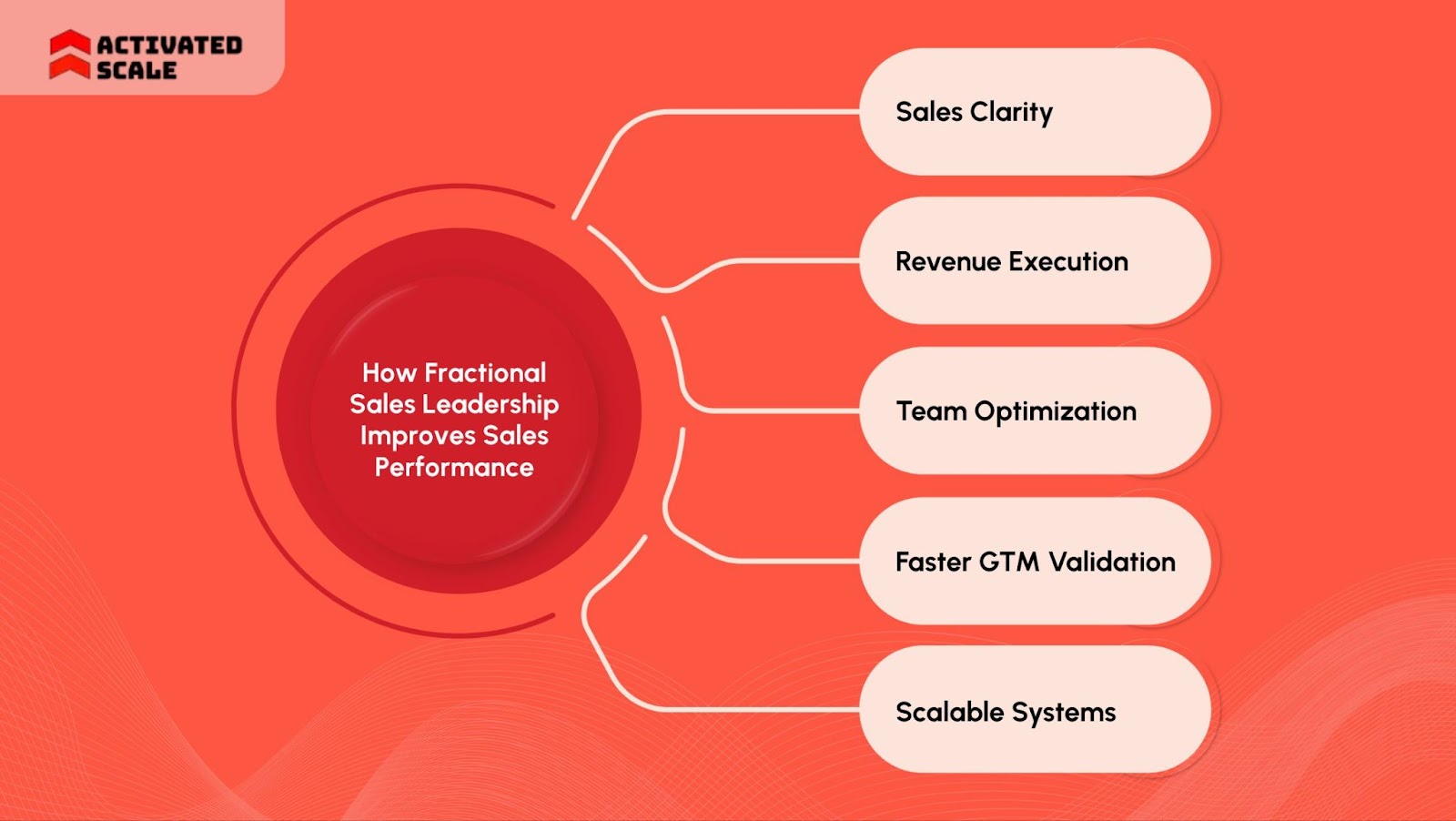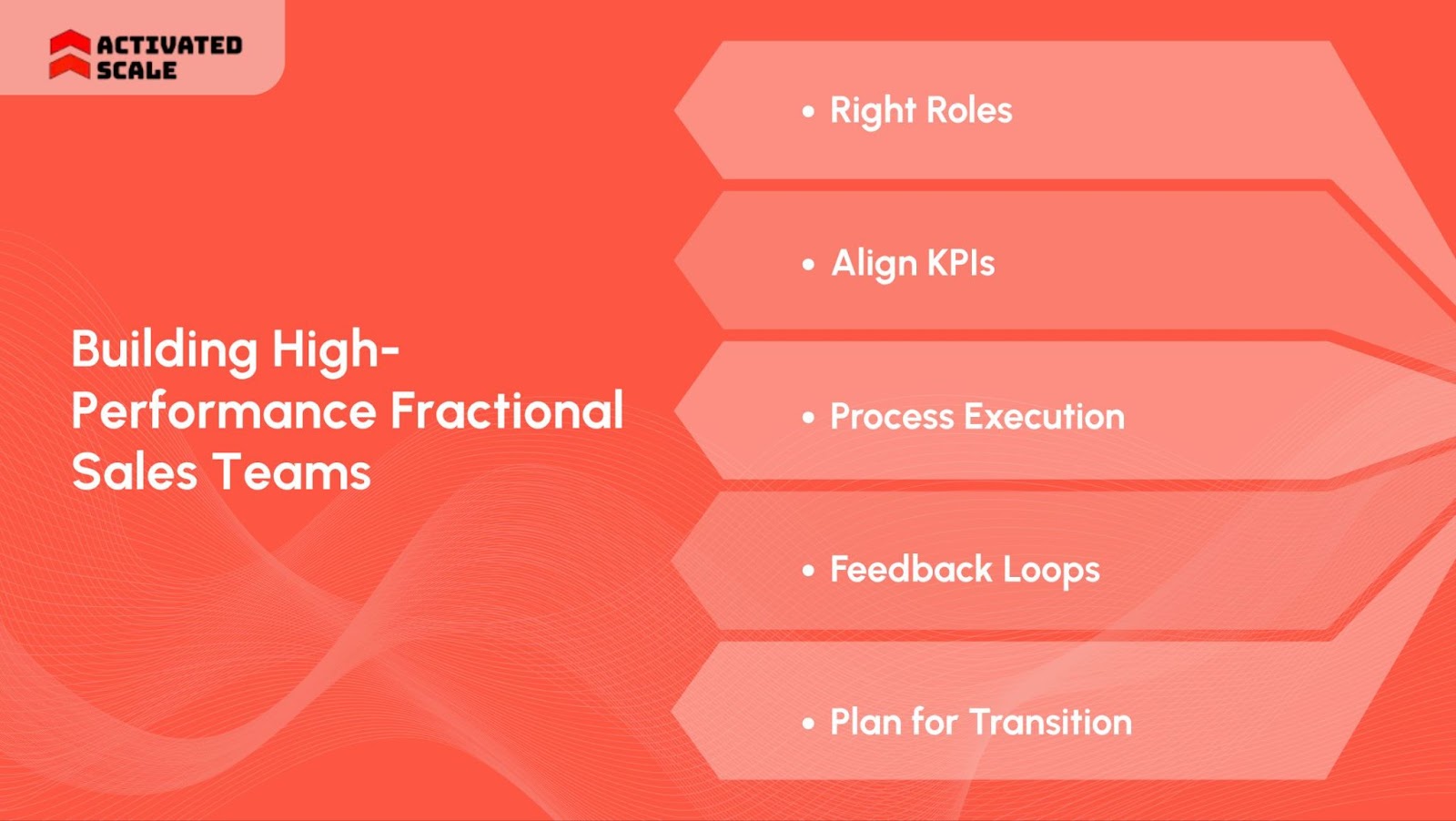Did you know that you can fuel your company’s next phase of growth with the expertise of a top-tier sales leader, without the overhead of a full-time executive?
In 2025, the adoption of fractional sales leadership models is projected to surge by 40% in the technology and startup sectors alone.
But why are so many ambitious founders and growth-stage businesses making this strategic shift? Because fractional sales leaders deliver the seasoned insight, agility, and data-driven execution needed to outpace the competition at a fraction of the cost.
In fact, companies using fractional sales leadership have reported sales revenue increases of up to 24% and a 31% jump in sales productivity per employee.
In this blog, we’ll explain what fractional sales leadership is, when to consider it, how it accelerates growth, and how to determine if it’s the right fit for your sales organization.
Key Summary (TL;DR)
- Fractional sales teams offer VP-level leadership and sales execution without the cost or delay of full-time hires.
- They accelerate growth by improving sales processes, aligning teams, validating GTM strategy, and installing scalable systems.
- Ideal for companies at growth inflection points, whether facing stalled revenue, market expansion, or leadership gaps.
- Activated Scale connects you with pre-vetted fractional sales leaders and SDRs, matched to your stage and goals in under 7 days.
What is Fractional Sales Leadership?
Fractional sales leadership refers to engaging a highly experienced sales executive, typically at the VP or CRO level, on a part-time or limited-term basis.
This leader is brought in to guide, manage, and improve a company’s sales function, delivering executive-level expertise without the full-time cost or commitment.
Rather than a full-time hire, fractional leaders embed themselves for 2–3 days a week over a defined period (commonly 3–6 months), driving strategic direction, execution oversight, and team development.
Think of it as VP-level leadership without full-time overhead. It is purpose-built for companies that need results quickly, but can’t afford the time or risk involved in hiring a full-time executive.
How Fractional Sales Leadership Improves Sales Performance

Fractional sales leaders drive measurable sales outcomes from week one. It offers a high-leverage growth solution for companies that can’t afford to wait or guess.
Here’s how:
- Sales Process Clarity
Fractional leaders bring a structured, diagnostic approach to uncover where deals are stalling and why.
They evaluate each stage of your funnel, from lead qualification to close, to identify gaps in messaging, handoff, follow-up cadence, or rep behavior.
This clarity allows the business to stop reacting to symptoms and start fixing root causes like shifting lead scoring criteria, reworking the discovery call structure, or tightening next-step tracking in the CRM.
- Revenue-Focused Execution
Instead of letting teams operate in functional silos, fractional sales executives align SDRs, AEs, marketing, and customer success around unified revenue targets and accountability metrics.
They define what success looks like at each role level: meetings booked, opportunities created, pipeline coverage, win rate, and set a cadence of weekly reviews to enforce it.
- Team Optimization
Fractional leaders assess rep performance not just by quota attainment, but by deal quality, velocity, and consistency.
They help founders and managers distinguish between underperformance that can be coached and true misalignment. They also help level up top performers through structured development plans and act as a sounding board for team restructuring and key hires.
- Faster GTM Validation:
A fractional executive can rapidly test and refine your go-to-market assumptions depending on whether you’re entering a new market, targeting a new ICP, or launching a new product line.
They stress-test your outbound strategy, discovery frameworks, and objection handling using data from real customer interactions, not intuition. This shortens the feedback loop on what works, what doesn’t, and where to double down.
- Scalable Systems
Beyond strategy, fractional leaders implement the infrastructure required for scale:
- CRMs that reflect real sales behavior
- Forecasting models that match buying patterns
- Compensation plans that reward the right actions
- Dashboards that surface issues before they become problems
They build these systems with your team, not just for them, ensuring long-term adoption.
Also Read: Top 10 Best CRM Software for Small Businesses in 2025
Key Differences from Traditional, Fractional Interim Sales Team
When Does Your Business Need Fractional Sales Leadership?
Think of fractional sales leadership as your company’s “growth catalyst”: a flexible, data-driven solution that turns inflection points into acceleration points.
Instead of waiting for a crisis, use these signals and metrics to proactively unlock the next level of sales performance and sustainable growth.
1. Are You Hitting a Growth Plateau?
If your revenue has stalled or you’re consistently missing sales targets, you’re not alone. According to Deloitte, companies that bring in fractional sales leadership see, on average, a 24% increase in sales revenue and a 31% rise in sales productivity per employee. If your current sales approach isn’t delivering, it may be time to inject outside expertise.
2. Are You Scaling, Pivoting, or Entering New Markets?
Periods of rapid growth, market expansion, or business transformation often expose gaps in sales strategy and leadership. Fractional sales leaders excel at building scalable processes, aligning teams, and driving execution during these critical transitions.
For example, startups that engaged fractional executives during scaling phases reported revenue jumps of up to 50% while maintaining customer satisfaction.
3. Is There a Leadership Gap or Lack of Sales Expertise?
Many startups and SMBs can’t justify a full-time VP of Sales but still need strategic leadership. Fractional leaders bring enterprise-level experience at a fraction of the cost, providing immediate impact without long-term overhead.
They’re especially effective when your team is talented but lacks direction, or when founders are stretched too thin to drive sales themselves.
4. Are Your Sales Processes and KPIs Underdeveloped?
If you lack structured sales processes, clear KPIs, or data-driven decision-making, a fractional sales leader can quickly implement best practices. Companies using this model have reported up to a 35% improvement in conversion rates and a 22% reduction in customer acquisition costs, transforming sales from a guessing game to a growth engine.
5. Are You Facing High Turnover or Low Morale in Your Sales Team?
Leadership voids often lead to disengaged teams and missed opportunities. Fractional leaders not only optimize strategy but also coach and develop internal talent, fostering a culture of accountability and continuous improvement.
Ideal Scenarios for Adopting Fractional Sales Leadership
- Stalled or unpredictable revenue growth
- Scaling headcount or entering new markets
- Transition periods (post-funding, M&A, or founder handoff)
- Need for specialized expertise (e.g., SaaS, enterprise sales)
- Budget constraints that preclude a full-time executive
Also Read: Essential Stages to Build a Strong B2B Sales Pipeline
Building High-Performance Fractional Sales Teams

Fractional means more than temporary or transactional; it means intentional, outcome-focused, and lean by design.
When built correctly, a fractional sales team can outperform full-time teams by delivering speed, clarity, and accountability without the overhead or lag time.
Here’s how high-performance fractional teams are structured, aligned, and optimized:
1. Assemble the Right Roles for the Right Outcomes
Start with your objective: pipeline generation, outbound execution, or closing capacity, and build backward. Fractional sales teams aren't about filling seats.
They're about assembling high-skill operators who can drive a defined outcome within a limited time frame.
Common configurations:
- SDR Pod (15–20 hrs/week): For outbound prospecting and appointment setting
- AE (20 hrs/week): For pipeline conversion, demos, and deal-closing
- Fractional VP of Sales (2–3 days/week): For leadership, process design, and team oversight
Approach: Don’t default to “what roles do we need?” Start with “What bottleneck are we solving?”
2. Align Around Clear KPIs and Ownership
In fractional models, misalignment kills velocity. Each contributor must be measured by what they own, not just what they contribute to.
For example:
- SDR → meetings booked per week, conversion from outbound touches to SQLs
- AE → demo-to-close ratio, win rate, deal cycle
- VP → forecast accuracy, process adoption, rep performance delta over time
Principle: No vague objectives. Every fractional contributor is hired to move specific numbers fast.
3. Operationalize With Process from Day One
Fractional teams only succeed if they’re built on systems, not heroics. That means:
- Predefined sequences and messaging templates
- Qualification frameworks embedded into the CRM
- Weekly cadence around pipeline reviews, call coaching, and reporting
- Clear SOPs for handoff between SDR → AE → CS
Execution Tip: Start with what must be consistent, and automate everything else.
4. Create Feedback Loops That Accelerate Performance
Fractional teams operate with compressed timelines, so learning has to happen in real time. Top-performing setups create:
- Weekly feedback from VPs to reps (not quarterly performance reviews)
- Shared dashboardsare visible to the founder or CRO
- Win/loss analysis every month
- Tight Slack/CRM integration for async check-ins
Result: Issues don’t linger. Wins get documented. Reps iterate faster.
5. Build for Transition, Not Dependency
The best fractional sales teams scale down smartly; not everything needs to remain fractional forever. The goal isn’t to outsource sales forever, but to use fractional talent to:
- Prove a sales model
- Generate a predictable pipeline
- Train internal hires
- Lay the infrastructure for a full-time team later (if needed)
Insight: The fractional team is not a stopgap; it’s your GTM lab, your early-stage accelerator, and your revenue insurance policy.
Integrating Fractional Sales Leadership into Your Organization
Seamless integration of a fractional sales leader is essential for unlocking their full value. Here’s how to ensure a smooth transition, strong alignment, and effective communication:
1. Steps for Onboarding and Aligning a Fractional Sales Leader
- Set Clear Expectations:
Define the fractional leader’s role, responsibilities, and key performance indicators (KPIs) from the outset. Document your sales process and clarify immediate priorities to avoid ambiguity.
- Structured Onboarding:
Provide a comprehensive introduction to your company’s products, customers, and current sales processes. Allow the leader to shadow existing team members or founders to absorb the company culture and sales approach.
- Phased Integration:
Start with core sales activities aligned to urgent needs, then gradually expand responsibilities as the leader gains familiarity and trust within the team.
- Resource Access:
Ensure the fractional leader has the necessary tools, data, and support to operate effectively from day one.
2. Ensuring Executive Alignment and Cross-Functional Collaboration
- Executive Buy-In:
Involve senior leadership early and communicate the strategic rationale for bringing in a fractional leader. Reinforce how this move supports broader business goals and growth targets.
- Collaborative Planning:
Facilitate regular alignment meetings between the fractional leader and existing management, including heads of marketing, product, and customer success. This ensures unified direction and maximizes cross-functional impact.
- Cultural Integration:
Invest time in helping the fractional leader understand and embody your company’s values and working style. Curate internal “culture champions” to support this transition and foster trust.
3. Communication Strategies for Seamless Integration
- Regular Check-Ins:
Establish a cadence of check-ins and progress reviews between the fractional leader, sales team, and executives. This keeps everyone aligned and allows for swift resolution of issues.
- Open Feedback Loops:
Create channels for real-time feedback and transparent discussion, ensuring concerns are addressed before they escalate.
- Inclusive Leadership:
Encourage the fractional leader to foster an inclusive environment, valuing input from all team members and promoting a sense of shared purpose.
Principle: Visibility builds credibility. The more internal alignment the leader has, the faster they can drive measurable outcomes.
Tip: Weekly 1:1s with the CEO and weekly syncs with frontline teams build trust and surface issues early..
Also Read: Understanding the Process and Methods of Sales Forecasting
Activated Scale: A Smarter Way to Deploy Fractional Sales Leadership
If you're exploring fractional sales leadership but don’t want to gamble on fit, speed, or results, Activated Scale removes the guesswork.
Through its curated marketplace, you can connect with pre-vetted, U.S.-based sales leaders with proven success in roles like VP of Sales, Sales Strategy, or GTM Execution.
These professionals are operators who’ve built and scaled revenue teams at high-growth companies, and they’re available on flexible, fractional terms.
Activated Scale ensures:
- Fast match times (often within 7 days)
- Role-to-skill alignment based on growth objectives
- Trial-to-hire pathways if full-time becomes the goal
Result: You get leadership that fits your stage, your goals, and your urgency, without the 6-month hiring delay.
Conclusion
Waiting for the “perfect hire” or stretching internal bandwidth can cost you more than just revenue. It can delay momentum, dilute your market positioning, and erode team confidence.
For founders and executives, the real opportunity lies in recognizing when to step beyond traditional hiring models. Relying on a fractional sales team and leadership can serve as a powerful catalyst for transformation.
Ready to see how fractional sales leadership can accelerate your company’s growth?
Activated Scale connects you with pre-vetted fractional sales leaders and SDRs aligned to your growth stage and objectives.
Book a discovery call to match with a fractional sales executive who can move the needle in your next 90 days.
FAQs
1. How quickly can a fractional sales team start delivering results compared to a traditional hire?
Fractional sales teams can often begin making an impact within days or weeks, thanks to their experience and streamlined onboarding processes. Unlike traditional hires, which may require months of recruitment and ramp-up, fractional professionals are accustomed to jumping in quickly, assessing needs, and implementing proven strategies almost immediately.
2. What technology or tools are essential for managing a fractional sales team effectively?
To ensure seamless collaboration and performance tracking, it’s critical to provide fractional sales teams with access to CRM systems, communication platforms (like Slack or Teams), and project management tools. These resources help maintain alignment, transparency, and accountability, especially when team members are remote or part-time.
3. Can a fractional sales team work alongside my existing full-time sales staff?
Yes, fractional sales teams are designed to complement and enhance your existing sales structure. They can fill leadership gaps, introduce new processes, or focus on specific projects without disrupting your current team. Clear communication and defined roles are key to ensuring both groups work cohesively toward shared goals.
4. What are the most common challenges when integrating a fractional sales team, and how can they be addressed?
Common challenges include maintaining team cohesion, ensuring consistent communication, and aligning the fractional team with company culture and objectives. These can be addressed by setting clear expectations, providing thorough onboarding, and scheduling regular check-ins to foster integration and accountability.
5. How do I measure the ROI of a fractional sales team?
ROI can be measured using key performance indicators (KPIs) such as lead generation, conversion rates, pipeline velocity, and revenue growth. Regularly reviewing these metrics, along with gathering feedback from stakeholders, helps determine the effectiveness and value delivered by the fractional sales team.
The Ultimate Guide to Hiring a Salesperson!
Get the step-by-step guide to hiring, onboarding, and ensuring success!
_edi.png)




